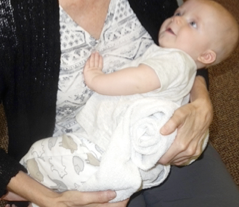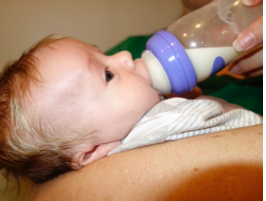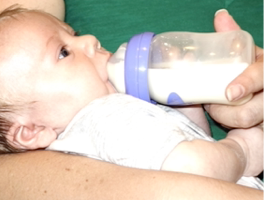Infant and Toddler Feeding
Medically-fragile infants and preterm infants are at risk for long-term feeding problems (Samara, Johnson, Lamberts, Marlow & Wolke, 2009; Rudolph & Link, 2002). Treatment is often focused on avoiding the development of maladaptive feeding behaviors, reducing hospital stays, and improving the transition from alternative feeding to oral feeding. Treatment may incorporate compensatory supports, such as feeding position and feeding presentation. For infants who are able to take in oral feeds, but have great difficulty in accomplishing adequate oral intake, cue-based feeding may be appropriate. For newborns and infants who are unable to participate in oral feeding due to medical complications, kangaroo care and non-nutritive oral motor therapies may be employed.
Feeding Supports
Unable to comply with direct treatment protocols, infant feeding therapy is often compensatory. Treatment strategies may include changes in feeding position or external pacing of liquid intake, which can be achieved through changes in nipple, changes in liquid viscosity or changes in bottle presentation.
Feeding Positions
Feeding position can be altered to improve oral intake, direct bolus flow, or reduce the risk of aspiration. Box 4.45 demonstrates common feeding positions and their uses. The cradle hold is the most common feeding position and is used for infants without swallow deficits. For infants with difficulty latching on, a cross-cradle hold allows the mother to assist in the latch process by directing and stabilizing the infant’s head. A football hold allows for a more upright trunk and may be useful for infants with aspiration risk or reflux, but may be avoided in infants who have poor oral pressures and incompetent anterior containment. Props, such as a rolled towel, may be added to help stabilize infants with poor tone (Box 4.46).
Box 4.45: Common infant feeding positions
|
Cradle Hold Most common infant feeding position. |
 |
|
Cross Cradle Hold Useful in breastfeeding when mother needs to stabilize or manipulate breast or provide pressure or control to infant’s head during feeding.Good for kids with difficulty latching on. |
 |
|
Football Hold Useful in breastfeeding for babies with reflux issues or aspiration risk, or mothers with good milk ejection or let down. |
 |
Box 4.46: Rolled towel as support

For babies with poor tone and GI stress, a supportive roll behind the back may aid in improved posture for feeding.
External Pacing
External pacing is the manipulation of the environment or feeding strategy to alter the rate of the flow of milk to the infant. It may be employed when the feeder observes gasping, poor coordination between suck-swallow-breathe, or pulling away from feeding (Ludwig & Waitzman, 2007). External pacing can be achieved by changing the flow rate of the nipple, using dynamic feeding or bottle positions throughout the feeding, or changing the viscosity of the liquid.
Pacing is typically performed with the infant in a more upright position with a stabilized head while holding the bottle in a horizontal position. The horizontal position requires the infant to do the muscular work to extract the liquid from the bottle, thereby also aiding in oral motor development. Moving the nipple in varying horizontal degrees can aid in pacing by emptying the nipple while maintaining the oral seal (Box 4.47).
Box 4.47: External pacing through nipple angle


External pacing may be achieved by tipping the nipple to reduce oral intake during the feeding. When the bottle is angled upward, the nipple is filled with milk, as the bottle is angled downward the nipple empties. This technique allows for external pacing without requiring the baby to unlatch and relatch onto the nipple.
Pacing can also be controlled by changing the flow rate of the nipple which manipulates the pressure needed to extract liquid from the nipple. While many nipple brands will have graded flow rates, flow rates vary across brands (Pados, Park, Thoyre, Estrem, & Nix, 2015). Therefore, consumers cannot use a slow-flow nipple from one brand and then a fast-flow nipple from another brand and assume a clear alteration in the flow parameters. When the flow rate is increased to a level that is not well tolerated by the infant, you will note physiologic instability in the sucking pattern or other stress cues. (Refer to infant stress cues presented in Box 1.36.)
Clinical Note
Gum-based thickeners can result in necrotizing enterocolitis in infants. There are over 20 deaths reported in the literature that are linked to the use of thickened liquids in preterm infants (Woods, Oliver, Lewis & Young, 2012; Clarke & Robinson, 2004; Beal, Silverman, Bellant, Young & Klontz, 2012). Therefore, xanthum gum-based thickeners should be avoided in infants.
Changing liquid viscosity will alter the flow rate and the work imposed on the sucking system. Yet, the use of thickeners to control flow may be inappropriate for an immature gut. As there are severe risks associated with some thickeners, this approach is typically used as a last resort. When used, careful consideration should be given to the thickener chosen. Consult with the feeding team to be sure to avoid any allergic reactions. Also note that infant guts are not well equipped to handle some thickeners, and gum-based thickeners have been linked to death in preterm infants. When choosing to use thickeners, do so with great care.
Oral Stability
For infants who have weak or uncoordinated oral motor function during swallow, external supports can be provided to aid in improved latch and sucking. Supports are typically applied manually by the feeder (Box 4.48). For breast fed infants who have poor oral pressure or squirrel liquid in the cheek cavity, when using a cradle hold, cheeks can be stabilized with the feeder’s free hand. Jaw movement can be aided by cradling the infant’s chin between two fingers and providing stability or movement as needed. For infants who have excessive anterior leakage and cannot tolerate a cradle hold (i.e., require a more upright feeding position), lip support can be provided by placing a finger below the lower lip.
Box 4.48: Manual supports for feeding infants with motor weakness
- Cheek stability may be useful when infants have poor pressure generation
- Jaw stability may be useful for infants with poor jaw motor function
- Lip stability may be useful for infants that lose liquid from the oral cavity yet accent tolerate a more reclined position, or infants who use their tongue in replace there lower jaw.
Infant-Driven Feeding
When feeding infants or training caregivers, infant-feeder communication should be employed to provide the best (least distressing) feeding experience. This requires that the feeding is focused on reading the baby’s cues rather than on counting the volume of intake. Based on dynamic systems theory, Shaker (2010) described a method of feeding whereby the infant’s system cues (e.g., oxygen saturations, skin color, heart rate) could be used to assess the success of the feeding activity. When feeding becomes a stressful activity, the physiologic state of the infant is altered in negative ways. This approach is in contrast to volume-based feeding, where feeding success is judged based on the amount of oral intake during a given feeding with no consideration of the infant’s feeding experience. Cue-based feeding is more supportive of healthy infant development given what we now know about the importance of infant physiological stability, the long term impact of positive feeding experiences, and caregiver attachment during feeding.
Clinical Note
The debate between cue-based feeding and volume based feeding can be quickly defused by considering the quality of the feeding experience. Stress associated with feeding can have long-term implications on brain development and feeding success in later years (Shaker, 2013).
Procedure
In cue-based feeding, feeders watch for cues of completion or distress to avoid training maladaptive feeding behaviors. This means that feeding time is performed in an environment that allows the feeder to focus on the feeding process and observe the infant. Babies and feeders should make eye contact during the feeding process. An averted infant gaze may indicate distress or completion of a feeding.
Efficacy
One concern expressed about cue-based feeding is the potential for weight loss or inadequate weight gain. However, the evidence does not support differences in weight gain for cue-based versus volume-based feeding approaches (Kirk, Adler & King, 2007; Puckett, Grover, Holt & Sankaran, 2008; Gelfer, McCarthy, & Spruill, 2015). In fact, there is evidence that cue-based feeding (as opposed to volume based or interval feeding schedules) leads to reduced hospital stays (McCain, Del Moral, Duncan, Fontaine, & Pino, 2012; Puckett, et al., 2008; McCain, Gartside, Greenberg, & Lott, 2001), and quicker transition to full oral intake (McCain et al., 2012; Puckett et al., 2008).
Treatment of Non-Oral or Medically-Fragile Infants
For infants who are unable to receive nutrition orally, therapy is geared towards (a) preventing the development of oral aversion, (b) providing oral experience and skill building, and (c) increasing awareness and acceptability of mealtime behaviors.
Non-Nutritive Sucking
Non-nutritive sucking (NNS) is simply the use of a pacifier to allow sucking without oral intake. It has been hypothesized that NNS can stabilize state and aid in oral motor development for medically-fragile infants who are unable to experience oral intake. In addition, this treatment approach may prevent the development of oral aversion, making the onset of feeding, once medically safe to do so, easier to achieve.
Procedure
The technique uses oral stimulation without oral intake. Typically it includes sucking on a pacifier or other device without expression of milk. If allowed, taste can be added to the non-nutritive protocol. For infants who have already developed an oral hypersensitivity and are unwilling to accept oral stimulation, treatment may start in the upper extremities and work its way towards the face and intraoral region.
Efficacy
While there is limited evidence to support the use of this treatment approach, in a clinical trial by Rocha and colleagues (2007), non-oral preterm infants who performed non-nutritive sucking achieved oral feeding quicker than their unstimulated peers. These infants also had shorter hospital stays (Rocha, Moreira, Pimenta, Ramos, & Lucena, 2007).
Oral Stimulation
Oral stimulation is a generic term for any tactile input to the oral region. It often involves stroking the peri-oral and intraoral region for a defined period of time at a defined delivery. For example, Fucile and colleagues described oral stimulation as a pre-feeding activity that includes stroking of the oral structures for approximately 15 minutes, at least 30 minutes prior to tube feeding (Box 4.49). Oral stimulation may be combined with a NNS activity. Several studies have reported a positive effect of oral stimulation for improving transition to oral feeding (Bache, Pizon, Jacobs, Vaillant, & Lecomte, 2013; Fucile, Gisel, & Lau, 2002,;Fucile, Gisel, McFarland, & Lau, 2011).
Box 4.49: Oral stimulation protocol (adapted from Fucile et al., 2002)
Time requirement
- Each item is repeated a minimum of 2 times or a duration of 1 minute.
- The program can be completed in approximately 15 minutes.
General considerations
- For patients with strong gag, avoid the posterior tongue. The goal is to provide the treatment without stimulating a gag.
- For tube fed infants, stimulation can be provided prior to tube feeding.
Procedural notes
- Stroking the peri-oral region– cheeks, upper and lower lip
- Using finger, provide pressure to the peri-oral region
- Stroking the intraoral region–upper and lower gum
- Start at the center and do each quadrant separately.
- Use firm and constant pressure applied to the gum line as you move the finger posteriorly along the gum line.
- If a gag is stimulated, stop at the point just before the gag is stimulated.
- Pressure to intraoral cheek tissue
- Place finger inside the cheek and press with an opposing finger.
- Move back from the corner of lips to back of the cheek
- Pressure to tongue
- place finger inside the mouth and press down and release on the tongue body
- Tongue range
- place finger along side the tongue and push the tongue body toward the opposite opposite side
Kangaroo Care
Kangaroo care incorporates skin to skin contact between caregiver and infant. It is used to aid in feeding readiness for medically-fragile infants. In addition, it is linked with improved health, temperature regulation, and bonding (Hunt, 2008). There is limited efficacy data to support this approach. However, the evidence shows that kangaroo care improves and stabilizes oxygen saturation, which sets the stage for more successful (less physiologic stress) feeding.
Treatment of Oral Aversion
Many preterm and medically-fragile infants are unable to receive oral intake due to respiratory status and need for ventilation rendering them dependent on alternate feeding approaches. For these infants oral experiences are often unpleasant, such as passing feeding tubes or endotracheal tubes. Dependence on tube feeding in the absence of positive oral experiences sets the stage for the development of oral aversion (Byars et al., 2003; Dodrill et al.,2004; Mason, Harris, & Blissett, 2005). Further, if the oral aversion persists into the toddler years, then these toddlers are unwilling to perform or participate in daily oral care (Stein, Polido, Mailloux, Coleman, & Cermak, 2011).
Procedure
For patients who are not ready for food or liquid, a variety of objects can be provided for oral exploration such as a pacifier, eating utensils, bottle nipples, blocks, etc… In the case that the infant is unwilling to allow items near the oral cavity, stimulation may begin distal to the mouth, and over time, work towards the face and oral region.
For infants who are approved for oral intake, but are prevented from adequate oral intake due to sensory aversion, treatment focuses on increasing sensory tolerance. Similar to the non-oral group, initial stimulation trials may start in the proximity of the mouth. However, depending on the tolerance level of the infant or toddler, treatment may begin on the hands, arms or neck. OT may serve to assist in the sensory tolerance program, especially when it involves stimulation distal to the mouth. Stimuli are graded with respect to volume, taste or texture. Changes should be made in only one parameter at a time. Whenever possible family members and caregivers should be engaged in the treatment session.
For toddlers who have been hospitalized long term, it may be important for them to observe other kids eating. Having never participated in a typical mealtime where groups gather to eat, the infant may consider oral input to be an unpleasant activity. It is useful for them to observe kids participating in and enjoying mealtime activities. Once observing the ease at which others complete the task of placing food in the oral cavity, they may be more intrigued and willing to give it a try.
Efficacy
While it is the opinion of the author that infants and toddlers have a more long term positive relationship with eating when treatment is measured and respectful of the current physiologic state, there is evidence to support the efficacy of flooding (also referred to as escape-extinction or purposeful feeding) in toddlers with severe oral aversion (Benoit, Wang, & Zlotin, 2000; Byers et al., 2003). In this scenario, food is provided for a defined period of time while ignoring the distress cues of the infant or toddler. Even a gag reflex is ignored. The feeder maintains the spoon in the mouth so that the child learns that the gag reflex does not lead to the food being removed. Overtime the negative reaction to oral input is reduced.
Hunger Provocation
As previously noted, dependence on tube feeding should be met with a treatment plan to reduce the onset of oral aversion. For patients who are medically stable and have a safe swallow, the transition plan should incorporate an interdisciplinary approach using various aspects in tune to the needs of the individual child. A common component in transition plans is hunger provocation (Hartdoff, Kneepkens,, Stok-Akerboom, Van Dijk-Lokkart, Engels, & Kinderman, 2015; Kinderman et al., 2008). Here the attempt is to normalize the gut to mealtimes and allow the infant or toddler to experience hunger. There are two steps to this approach. First continuous tube feeds are switched to a larger bolus delivered over a shorter time period. Second, once bolus feeds are stabilized, the amount delivered via the tube is decreased over time in hopes that the child will experience hunger. Hunger provocation may be combined with other techniques such as oral stimulation or purposeful feeding.

